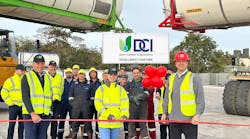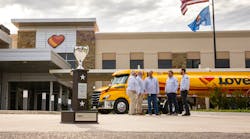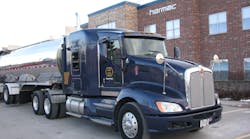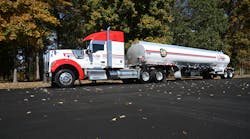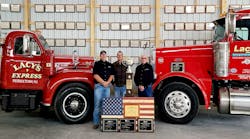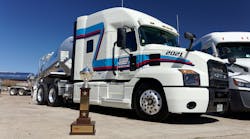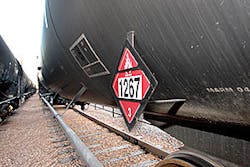The Railway Supply Institute Committee on Tank Cars (RSICTC)is urging the Department of Transportation’s Pipeline and Hazardous Materials Safety Administration (PHMSA) to support rulemaking that would enhance the safety of the North American tankcar fleet. Even as the committee expressed support for new tankcar safety standards, recent incidents involving crude oil unit trains have put the spotlight on older tankcars.
RSICTC supports the formal adoption by PHMSA of the safety standards for newly built tankcars that have already been adopted by the Association of American Railroads Tank Car Committee (AARTCC), and proposes the modification of the current tankcar fleet in a manner that substantially enhances safety while minimizing the engineering risks associated with certain other modification proposals. The RSICTC’s action came in response to a PHMSA Advance Notice of Proposed Rulemaking seeking recommendations to improve the safety of railroad tankcar transportation.
“The RSICTC recommendations and enhancements will contribute to improved safety while addressing the engineering risks and practical constraints associated with other modification proposals,” says RSI President Tom Simpson, speaking on behalf of the RSICTC. He noted that these recommendations would apply to railroad tankcars transporting Class 3, packing group I and II flammable liquids, as well as all tankcars carrying ethanol and crude oil, regardless of packing group.
“It is appropriate that this new rulemaking focus on crude oil and ethanol, as shipment of these commodities by railroad unit train has recently experienced tremendous growth in volume. Lower-hazard flammable liquids have not been involved in any of the incidents about which stakeholders are concerned and should not be inadvertently swept up in this rulemaking.”
In its comments, RSICTC also supported efforts to improve railroad operating practices and procedures and encouraged the USDOT to publish the final rule on improved rail integrity. RSICTC also supports actions by PHMSA to reduce the risk of misidentification of appropriate hazard class within established DOT hazardous material regulations.
The standard that the RSICTC is asking PHMSA to incorporate into its final rule was developed and proposed by AARTCC in 2011 as a new standard for the construction of new DOT111 tank cars carrying packing groups I and II flammable liquids. It included enhanced end of tank protection in the form of head shields, thicker tank car steel for certain car types, and top fittings protection. The industry agreed that this new standard would apply to cars ordered after October 1, 2011.
The key tankcar enhancements for newly constructed tankcars included in the RSI recommendation include:
• PG I and II flammable liquids tankcars to be constructed to 286,000-lb Gross Rail Load standards;
• Heads and shells must be constructed of normalized steel;
• New cars must at a minimum be equipped with one-half inch thick half-height protective head shields;
• For tankcars constructed of normalized TC128 Grade B steel, head and shell thickness must be one-half inch for non-jacketed cars and seven-sixteenths of an inch for jacketed cars;
• For tankcars constructed of normalized A516-70 steel, shells of non-jacketed tankcars must be nine-sixteenths of an inch thick while shells of jacketed tankcars must be one-half inch thick;
• Top fittings must be protected by a protective structure as tall as the tallest fitting;
• Installation of a reclosing pressure-relief valve;
• Protective bottom outlet assemblies.
The RSI Committee also asked PHMSA to allow tankcars currently built or on order to this new industry standard to remain in service for their normal regulatory life with the new safety-relief valve once it has been installed. For the balance of the affected tank car fleet, RSICTC asked PHMSA to allow tankcar owners to modify, re-purpose or retire cars as appropriate. For non-jacketed cars to remain in their current service, RSICTC recommends that they be modified with a head shield and the new pressure-relief valve, that there be a reduction in fittings height or other top fittings protection as appropriate for a particular tankcar design, and that the bottom outlet valve handles be removed in transit or otherwise protected to ensure closure. Jacketed cars would be exempt from modification unless it is determined that the new pressure-relief valve and bottom outlet handle arrangement is necessary.
RSICTC has recommended that this modification process be implemented over a 10-year period starting with publication of the PHMSA rulemaking. The individual car owners, in conjunction with the Federal Railroad Administration, would determine the order and timing of the modifications, taking into consideration the capacity of railroad shops to schedule and complete the modifications.
In direct response to PHMSA’s questions regarding the utility of thermal protection systems for newly manufactured and existing tankcars, RSICTC notes that while the use of thermal jacketing or spray-on thermal protection might provide secondary safety benefits, the application of jackets to existing non-jacketed cars is fraught with engineering risks and practical constraints. The RSI Committee’s modification proposal achieves a substantial safety improvement for existing non-jacketed cars while avoiding these risks. ♦

